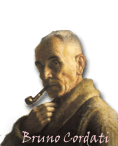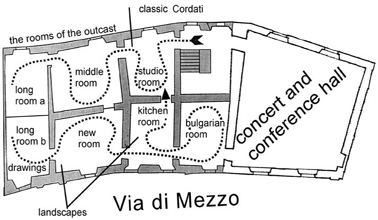
Currently in its ninth year of activity, the museum-home
Casa Cordati maintains unchanged the exposition space inaugurated
in 2001.
Shown in the Studio Room (sala dello studio), where artist Bruno
Cordati worked during his last years, are his classic works dating
back to the '20s and '30s, described by Emilio Pasquini as "highly
human in content". These paintings, as for example Maschietta,
were exhibited in various shows of the period, leading the way to
Cordati's participation at the Venice Biennale in 1928.
The invitation to the Venice Biennale came even though, four years
before, Carassiti had polemically written: "the connoisseurs
in Turin and Rome, in Venice and Florence, and the public whose
competence finds its best expression in the phrases 'I like it'
and 'I don't like it', have convinced Cordati that he should continue
and persevere in his Art, which certainly doesn't need the consecration
of these very official events". He was arguing against those
biennial and quadrennial exhibitions which "built a fence around
their halls, as in a country fair, and give access only to the groups
catering to those who hold the reins of the artistic movement".
In an article from that time (1930), L. G. Paolini praised Cordati's
"precise drawing technique, rigorous perspective planes and
highly effective contrasts of light". Two years later, in L'Eroica,
Cozzani wrote about his use of colour "...which is never muddy
and nebulous, but rises from the darkest greys and browns to the
boldest shades of white, green, red and yellow, through free associations
of tones which blend and confer a sense of daring yet harmonious
modern music".
The Middle Room (sala di mezzo) has been called this way since
1985, when the first posthumous show of Bruno Cordati was organised.
At that time the exposition space only comprised the three rooms
facing the garden, and this was the room in the in the middle. The
last room, called Long Room (sala lunga), was modified in 1997 by
artist Alberto Garutti, who subdivided it and enlarged the exhibition
area that had characterised Casa Cordati in its first three years
as museum-home. Since Garutti's intervention, there have been Long
Room A (sala lunga A) and Long Room B (sala lunga B).

In the Middle Room and the Long Room A, visitors can view works
from the '60s and '70s that have never been shown before. As in
last year's selection, they follow a theme, a common thread, which
made us want to change the rooms' name into the Rooms of the Outcast
(stanze degli ultimi). Such a name was inspired by a few excerpts
from Cesare Garboli's essay "Un giorno a Barga" (A day
in Barga), in the catalogue of the show held in Florence in 1987,
at the Nuova Strozzina, and organised by Antonio Del Guercio.
"...the poor; but poor thrown in this state by life... offended
by that stupidity and opaque astonishment brought by hopeless suffering".
"...the almost fanatical love for the poor, for the beggars,
the outcast, the wretched, the defeated, the 'sons of Saturn'".
The works on display in the Middle Room cover a recurring theme,
which could be described as the absence of dialogue and human contact,
or perhaps as the pain stemming from this absence, though this might
seem in contrast with the physical closeness depicted in the works.
Retracing one's steps, one enters the Kitchen Room (sala della
cucina) and the New Room (sala nuova), the latter owing its name
to the fact that it was the last room added to Casa Cordati's museum
space.
In these rooms we attempted to delineate, as far as it was possible,
the evolution of landscape in Bruno Cordati's art, in spite of the
fact that many critics have underlined how landscape never prevailed
in Cordati's works.
The Room of Drawings (sala dei disegni) provides a curious window
on Cordati's work which we wished to maintain, and includes mostly
studies and sketches. The Bulgarian Room (sala bulgara), instead,
is a new addition, containing works dated from 1939 to 1943, when
Cordati taught in Bulgaria. Here it might seem as if we are discovering
a different artist; during one of the happiest periods of his life,
in fact, Cordati painted in "exceptionally rich and luminous"
tones (Paccagnini).
Personal
and collective exhibition
- 1921
Pacini Institute, Lucca
- 1922
Permanent Exhibition, Bagni di Lucca
- 1923
First Regional artistic exhibition, Casino dei Nobili, Lucca
- 1925
First artistic exhibition, Barga
- 1926
IV Spring Exhibition, Livorno
- 1927
XCIII Esposizione Amatori e Cultori delle Belle Arti
- 1928
II Art Exhibition, Fiume
- 1928
XVI International Art Exhibition, Venice
- 1929
Palazzo Ducale, Lucca
- 1930
IV Regional Tuscan Art Exhibition, Florence
- 1930
Personal Exhibition, Circolo Lucchese, Lucca
- 1931
II Provincial Exhibition of Art, Lucca
- 1931
Personal Exhibition, Bottega d'Arte, Livorno
- 1931
Personal Exhibition, Barga
- 1931
Personal Exhibition, Casa d'Arte, La Spezia
- 1932
Personal Exhibition, Circolo Lucchese, Lucca
- 1932
Personal Exhibition, Kursaal, Viareggio
- 1934
Personal Exhibition, Circolo Centro, Viareggio
- 1934
I Summer Exhibition, Kursaal, Viareggio
- 1935
Art exhibition, Barga
- 1937
IV Art Exhibition, Lucca
- 1945
Provincial Art Exhibition, Lucca
- 1946
II Provincial Art Exhibition, Lucca
- 1947
Art Exhibition, Barga
- 1978
Art in Lucca 1900-1945, Palazzo Mansi, Lucca
- 1980
Retrospective Exhibition, Barga
- 1985
Anthological Exhibition, Barga
- 1986
Anthological Exhibition, La Nuova Strozzina (Palazzo Strozzi),
Florence
- 1988
Anthological Exhibition, Palazzo Lanfranchi, Pisa
- 1990
Anthological Exhibition, Sophia and Plovdiv, Bulgaria
- 1993
Anthological Exhibition, Fontana del Delfino Gallery, Bergamo
- Since
1994 Permanent Exhibition, Palazzo Cordati, Barga.
|